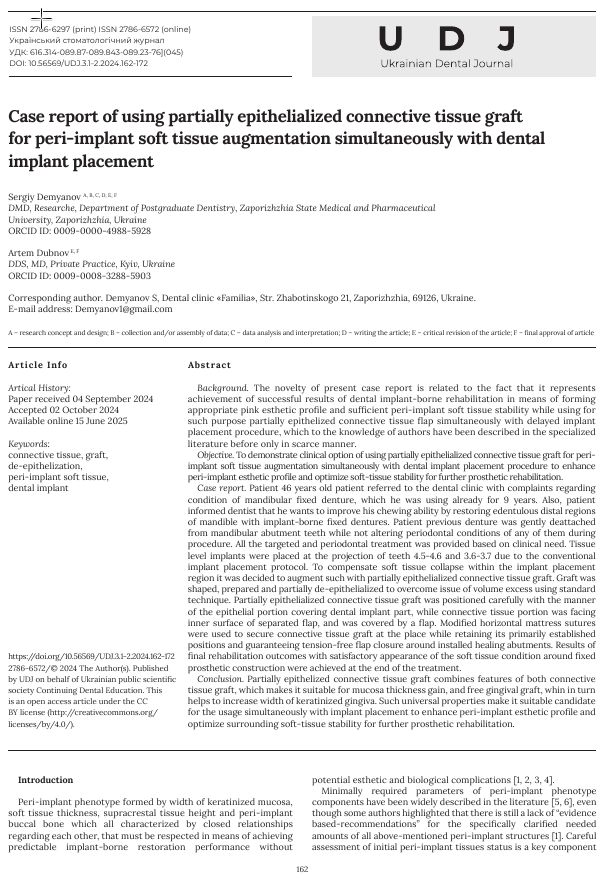Використання частково епітелізованого сполучнотканинного трансплантата з метою одночасної дентальної імплантації та аугментації періімплантних м'яких тканин. Звіт про клінічний випадок
DOI:
https://doi.org/10.56569/UDJ.3.1-2.2024.162-172Ключові слова:
сполучнотканинний трансплантат, деепітелізація, періімплантатні м’які тканини, дентальна імплантаціяАнотація
Вступ. Новизною представленого клінічного випадку є досягнення успішних результатів імплантат-ортопедичної реабілітації завдяки формуванню адекватного «рожевого» естетичного профілю та забезпечення стабільності періімплантатних м’яких тканин із застосуванням частково епітелізованого сполучнотканинного трансплантата одночасно із відтермінованим встановленням дентальних імплантатів. За наявними відомостями, подібна методика лише епізодично описувалася в спеціалізованій літературі.
Мета. Продемонструвати клінічну можливість використання частково епітелізованого сполучнотканинного трансплантата для збільшення об’єму періімплантатних м’яких тканин під час встановлення дентальних імплантатів з метою покращення естетичного профілю та оптимізації стабільності м’яких тканин для подальшої протетичної реабілітації.
Клінічний випадок. Пацієнт, 46 років, звернувся до стоматологічної клініки зі скаргами на незадовільний функціональний стан нижнього фіксованого протеза, яким користувався протягом 9 років. Крім того, пацієнт висловив бажання покращити жувальну функцію шляхом відновлення беззубих дистальних ділянок нижньої щелепи за допомогою ортопедичних конструкцій фіксованих на імплантати. Попередній протез було делікатно демонтовано з опорних зубів без порушення їх пародонтального стану. Усі необхідні терапевтичні та пародонтологічні втручання були проведені відповідно до клінічних показань. Дентальні імплантати були встановлені у позиції зубів 4.5–4.6 та 3.6–3.7 згідно зі стандартним протоколом Tissue Level. З метою компенсації дефіциту м’яких тканин у зонах імплантації було прийнято рішення про їх збільшення частково епітелізованим сполучнотканинним трансплантатом. Трансплантат був сформований, підготовлений та частково депітелізований для уникнення надмірного об’єму за стандартною методикою. Трансплантат був розташований таким чином, що епітелізована частина покривала ділянку імплантата, тоді як сполучнотканинна частина прилягала до внутрішньої поверхні відшарованого клаптя й була закрита ним. Для фіксації трансплантата застосовували модифіковані горизонтальні матрацні шви, що забезпечували стабільність його позиції та герметичне закриття клаптя навколо формувачів ясен. У фіналі лікування досягнуто задовільних функціональних та естетичних результатів із належним станом м’яких тканин навколо ортопедичної конструкції.
Висновки. Частково епітелізований сполучнотканинний трансплантат поєднує властивості сполучнотканинного трансплантата, придатного для збільшення товщини слизової оболонки, та вільного ясеневого трансплантата, який, у свою чергу, дозволяє розширити зону кератинізованої ясеневої тканини. Завдяки універсальним характеристикам він може бути доцільним варіантом для застосування одночасно зі встановленням імплантатів з метою покращення періімплантатного естетичного профілю та підвищення стабільності навколишніх м’яких тканин для подальшої протетичної реабілітації.
Ключові слова: сполучнотканинний трансплантат, деепітелізація, періімплантатні м’які тканини, дентальна імплантація
Заява про конфлікт інтересів
Автори не мають потенційного конфлікту інтересів, який може вплинути на рішення про публікацію цієї статті.
Заява про фінансування
Не було отримано жодного фінансування для допомоги в підготовці та проведенні цього дослідження, а також у написанні цієї статті.
Посилання
1. Wang IC, Barootchi S, Tavelli L, Wang HL. The peri‐implant phenotype and implant esthetic complications. Contemporary overview. J Esthet Restor Dent. 2021;33(1):212-23. doi: https://doi.org/10.1111/jerd.12709
2. Tavelli L, Barootchi S, Avila‐Ortiz G, Urban IA, Giannobile WV, Wang HL. Peri‐implant soft tissue phenotype modification and its impact on peri‐implant health: a systematic review and network meta‐analysis. J Periodontol. 2021;92(1):21-44. doi: https://doi.org/10.1002/JPER.19-0716
3. Lin CY, Kuo PY, Chiu MY, Chen ZZ, Wang HL. Soft tissue phenotype modification impacts on peri-implant stability: a comparative cohort study. Clin Oral Investig. 2023;27(3):1089-100. doi: https://doi.org/10.1007/s00784-022-04697-2
4. Gharpure AS, Latimer JM, Aljofi FE, Kahng JH, Daubert DM. Role of thin gingival phenotype and inadequate keratinized mucosa width (< 2 mm) as risk indicators for peri‐implantitis and peri‐implant mucositis. J Periodontol. 2021;92(12):1687-96. doi: https://doi.org/10.1002/JPER.20-0792
5. Monje A, Salvi GE. Diagnostic methods/parameters to monitor peri‐implant conditions. Periodontol 2000. 2024;95(1):20-39. doi: https://doi.org/10.1111/prd.12584
6. Monje A, González‐Martín O, Ávila‐Ortiz G. Impact of peri‐implant soft tissue characteristics on health and esthetics. J Esthet Restor Dent. 2023;35(1):183-96. doi: https://doi.org/10.1111/jerd.13003
7. Quispe‐López N, Gómez‐Polo C, Zubizarreta‐Macho Á, Montero J. How do the dimensions of peri‐implant mucosa affect marginal bone loss in equicrestal and subcrestal position of implants? A 1‐year clinical trial. Clin Implant Dent Relat Res. 2024;26(2):442-56. doi: https://doi.org/10.1111/cid.13306
8. Quispe-López N, Guadilla Y, Gómez-Polo C, Lopez-Valverde N, Flores-Fraile J, Montero J. The influence of implant depth, abutment height and mucosal phenotype on peri‑implant bone levels: A 2-year clinical trial. J Dent. 2024;148:105264. doi: https://doi.org/10.1016/j.jdent.2024.105264
9. Thoma DS, Gil A, Hämmerle CH, Jung RE. Management and prevention of soft tissue complications in implant dentistry. Periodontol 2000. 2022;88(1):116-29. doi: https://doi.org/10.1111/prd.12415
10. Thoma DS, Benić GI, Zwahlen M, Hämmerle CH, Jung RE. A systematic review assessing soft tissue augmentation techniques. Clin Oral Implants Res. 2009;20:146-65. doi: https://doi.org/10.1111/j.1600-0501.2009.01784.x
11. Mancini L, Simeone D, Roccuzzo A, Strauss FJ, Marchetti E. Timing of soft tissue augmentation around implants: A clinical review and decision tree. Int J Oral Implantol (Berl). 2023;16(4):282-302.
12. Lin CY, Chen Z, Pan WL, Wang HL. Impact of timing on soft tissue augmentation during implant treatment: A systematic review and meta‐analysis. Clin Oral Implants Res. 2018;29(5):508-21. doi: https://doi.org/10.1111/clr.13148
13. Fatani B, Alshlawi H, Fatani A, Almuqrin R, Aburaisi MS, Awartani F, Aburaisi M. Modifications in the free gingival graft technique: A systematic review. Cureus. 2024;16(4):e58932. doi: https://doi.org/10.7759/cureus.58932
14. Cortellini P, Tonetti M, Prato GP. The partly epithelialized free gingival graft (pe‐fgg) at lower incisors. A pilot study with implications for alignment of the mucogingival junction. J Clin Periodontol. 2012;39(7):674-80. doi: https://doi.org/10.1111/j.1600-051X.2012.01896.x
15. Park WB, Park W, Kang P, Lim HC, Han JY. Submerged technique of partially de-epithelialized free gingival grafts for gingival phenotype modification in the maxillary anterior region: a case report of a 34-year follow-up. Medicina. 2023;59(10):1832. doi: https://doi.org/10.3390/medicina59101832
16. Kinaia BM, Kazerani S, Hsu YT, Neely AL. Partly deepithelialized free gingival graft for treatment of lingual recession. Clin Adv Periodontics. 2019;9(4):160-5. doi: https://doi.org/10.1002/cap.10062
17. De Angelis P, De Angelis S, Passarelli PC, Liguori MG, Pompa G, Papi P, Manicone PF, D’Addona A. Clinical comparison of a xenogeneic collagen matrix versus subepithelial autogenous connective tissue graft for augmentation of soft tissue around implants. Int J Oral Maxillofac Surg. 2021;50(7):956-63. doi: https://doi.org/10.1016/j.ijom.2020.11.014
18. Stefanini M, Barootchi S, Sangiorgi M, Pispero A, Grusovin MG, Mancini L, Zucchelli G, Tavelli L. Do soft tissue augmentation techniques provide stable and favorable peri‐implant conditions in the medium and long term? A systematic review. Clin Oral Implants Res. 2023;34:28-42. doi: https://doi.org/10.1111/clr.14150
19. Poskevicius L, Sidlauskas A, Galindo‐Moreno P, Juodzbalys G. Dimensional soft tissue changes following soft tissue grafting in conjunction with implant placement or around present dental implants: a systematic review. Clin Oral Implants Res. 2017;28(1):1-8. doi: https://doi.org/10.1111/clr.12606
20. Aldhohrah T, Qin G, Liang D, Song W, Ge L, Mashrah MA, Wang L. Does simultaneous soft tissue augmentation around immediate or delayed dental implant placement using sub-epithelial connective tissue graft provide better outcomes compared to other treatment options? A systematic review and meta-analysis. PLoS One. 2022;17(2):e0261513. doi: https://doi.org/10.1371/journal.pone.0261513
21. Lin CY, Nevins M, Kim DM. Laser De-epithelialization of Autogenous Gingival Graft for Root Coverage and Soft Tissue Augmentation Procedures. Int J Periodontics Restorative Dent. 2018;38(3):405-411. doi: https://doi.org/10.11607/prd.3587.
22. Makker K, Yadav VS, Nayyar V, Mishra D. Histomorphometric assessment of extra-versus intra-oral de-epithelialization methods for palatal connective tissue graft: a case series. Curr Trends Dent. 2024;1(2):112-5. doi: https://doi.org/10.4103/CTD.CTD_28_24
23. Bara-Gaseni N, Jorba-Garcia A, Alberdi-Navarro J, Figueiredo R, Bara-Casaus JJ. Histological assessment of a novel de-epithelialization method for connective tissue grafts harvested from the palate. An experimental study in cadavers. Clin Oral Investig. 2024;28(6):343. doi: https://doi.org/10.1007/s00784-024-05734-y
24. Hazrati P, Baniameri S, Sabri H, Chele D, Stuhr S. Efficacy of LASER for de-epithelialization of free gingival graft: a systematic review. Lasers Med Sci. 2025;40(1):1-2. doi: https://doi.org/10.1007/s10103-025-04554-0
25. Din F, Kabalak MÖ, Yılmaz BT, Barış E, Avcı H, Çağlayan F, Keceli HG. Efficacy of different gingival graft de-epithelialization methods: A parallel-group randomized clinical trial. Clin Oral Investig. 2025 May 7;29(6):289. doi: https://doi.org/10.1007/s00784-025-06365-7
26. Frisch E, Ratka‐Krüger P. A new technique for peri‐implant recession treatment: Partially epithelialized connective tissue grafts. Description of the technique and preliminary results of a case series. Clin Implant Dent Relat Res. 2020;22(3):403-8. doi: https://doi.org/10.1111/cid.12897
27. Fawzy M, Hosny M, El-Nahass H. Evaluation of esthetic outcome of delayed implants with de-epithelialized free gingival graft in thin gingival phenotype with or without immediate temporization: a randomized clinical trial. Int J Implant Dent. 2023;9(1):5. doi: https://doi.org/10.1186/s40729-023-00468-0
28. Ripoll S, Fernández de Velasco-Tarilonte Á, Bullón B, Ríos-Carrasco B, Fernández-Palacín A. Complications in the use of deepithelialized free gingival graft vs. connective tissue graft: a one-year randomized clinical trial. Int J Environ Res Public Health. 2021;18(9):4504. doi: https://doi.org/10.3390/ijerph18094504
29. Zangrando MS, Eustachio RR, de Rezende ML, Sant'ana AC, Damante CA, Greghi SL. Clinical and Patient‐Centered outcomes using two types of subepithelial connective tissue grafts: a Split‐Mouth randomized clinical trial. J Periodontol. 2021;92(6):814-22. doi: https://doi.org/10.1002/JPER.19-0646
30. Zucchelli G, Mele M, Stefanini M, Mazzotti C, Marzadori M, Montebugnoli L, De Sanctis M. Patient morbidity and root coverage outcome after subepithelial connective tissue and de‐epithelialized grafts: a comparative randomized‐controlled clinical trial. J Clin Periodontol. 2010;37(8):728-38. doi: https://doi.org/10.1111/j.1600-051X.2010.01550.x
31. Beymouri A, Yaghobee S, Khorsand A, Safi Y. Comparison of morbidity at the donor site and clinical efficacy at the recipient site between two different connective tissue graft harvesting techniques from the palate: A randomized clinical trial. J Adv Periodontol Implant Dent. 2023;15(2):108-116. doi: https://doi.org/10.34172/japid.2023.016
32. Naziker Y, Ertugrul AS. Aesthetic evaluation of free gingival graft applied by partial de-epithelialization and free gingival graft applied by conventional method: a randomized controlled clinical study. Clin Oral Investig. 2023;27(7):4029-38. doi: https://doi.org/10.1007/s00784-023-05029-8
33. Corrado F, Marconcini S, Cosola S, Giammarinaro E, Covani U. Immediate implant and customized healing abutment promotes tissues regeneration: A 5-year clinical report. J Oral Implantol. 2023;49(1):19-24. doi: https://doi.org/10.1563/1548-1336-49.1.19
34. Chokaree P, Poovarodom P, Chaijareenont P, Yavirach A, Rungsiyakull P. Biomaterials and clinical applications of customized healing abutment—a narrative review. J Funct Biomater. 2022;13(4):291. doi: https://doi.org/10.3390/jfb13040291alawi H, Fatani A, Almuqrin R, Aburaisi MS, Awartani F, Aburaisi M. Modifications in the free gingival graft technique: A systematic review. Cureus. 2024;16(4):e58932. doi: https://doi.org/10.7759/cureus.58932
14. Cortellini P, Tonetti M, Prato GP. The partly epithelialized free gingival graft (pe‐fgg) at lower incisors. A pilot study with implications for alignment of the mucogingival junction. J Clin Periodontol. 2012;39(7):674-80. doi: https://doi.org/10.1111/j.1600-051X.2012.01896.x
15. Park WB, Park W, Kang P, Lim HC, Han JY. Submerged technique of partially de-epithelialized free gingival grafts for gingival phenotype modification in the maxillary anterior region: a case report of a 34-year follow-up. Medicina. 2023;59(10):1832. doi: https://doi.org/10.3390/medicina59101832
16. Kinaia BM, Kazerani S, Hsu YT, Neely AL. Partly deepithelialized free gingival graft for treatment of lingual recession. Clin Adv Periodontics. 2019;9(4):160-5. doi: https://doi.org/10.1002/cap.10062
17. De Angelis P, De Angelis S, Passarelli PC, Liguori MG, Pompa G, Papi P, Manicone PF, D’Addona A. Clinical comparison of a xenogeneic collagen matrix versus subepithelial autogenous connective tissue graft for augmentation of soft tissue around implants. Int J Oral Maxillofac Surg. 2021;50(7):956-63. doi: https://doi.org/10.1016/j.ijom.2020.11.014
18. Stefanini M, Barootchi S, Sangiorgi M, Pispero A, Grusovin MG, Mancini L, Zucchelli G, Tavelli L. Do soft tissue augmentation techniques provide stable and favorable peri‐implant conditions in the medium and long term? A systematic review. Clin Oral Implants Res. 2023;34:28-42. doi: https://doi.org/10.1111/clr.14150
19. Poskevicius L, Sidlauskas A, Galindo‐Moreno P, Juodzbalys G. Dimensional soft tissue changes following soft tissue grafting in conjunction with implant placement or around present dental implants: a systematic review. Clin Oral Implants Res. 2017;28(1):1-8. doi: https://doi.org/10.1111/clr.12606
20. Aldhohrah T, Qin G, Liang D, Song W, Ge L, Mashrah MA, Wang L. Does simultaneous soft tissue augmentation around immediate or delayed dental implant placement using sub-epithelial connective tissue graft provide better outcomes compared to other treatment options? A systematic review and meta-analysis. PLoS One. 2022;17(2):e0261513. doi: https://doi.org/10.1371/journal.pone.0261513
21. Lin CY, Nevins M, Kim DM. Laser De-epithelialization of Autogenous Gingival Graft for Root Coverage and Soft Tissue Augmentation Procedures. Int J Periodontics Restorative Dent. 2018;38(3):405-411. doi: https://doi.org/10.11607/prd.3587.
22. Makker K, Yadav VS, Nayyar V, Mishra D. Histomorphometric assessment of extra-versus intra-oral de-epithelialization methods for palatal connective tissue graft: a case series. Curr Trends Dent. 2024;1(2):112-5. doi: https://doi.org/10.4103/CTD.CTD_28_24
23. Bara-Gaseni N, Jorba-Garcia A, Alberdi-Navarro J, Figueiredo R, Bara-Casaus JJ. Histological assessment of a novel de-epithelialization method for connective tissue grafts harvested from the palate. An experimental study in cadavers. Clin Oral Investig. 2024;28(6):343. doi: https://doi.org/10.1007/s00784-024-05734-y
24. Hazrati P, Baniameri S, Sabri H, Chele D, Stuhr S. Efficacy of LASER for de-epithelialization of free gingival graft: a systematic review. Lasers Med Sci. 2025;40(1):1-2. doi: https://doi.org/10.1007/s10103-025-04554-0
25. Din F, Kabalak MÖ, Yılmaz BT, Barış E, Avcı H, Çağlayan F, Keceli HG. Efficacy of different gingival graft de-epithelialization methods: A parallel-group randomized clinical trial. Clin Oral Investig. 2025 May 7;29(6):289. doi: https://doi.org/10.1007/s00784-025-06365-7
26. Frisch E, Ratka‐Krüger P. A new technique for peri‐implant recession treatment: Partially epithelialized connective tissue grafts. Description of the technique and preliminary results of a case series. Clin Implant Dent Relat Res. 2020;22(3):403-8. doi: https://doi.org/10.1111/cid.12897
27. Fawzy M, Hosny M, El-Nahass H. Evaluation of esthetic outcome of delayed implants with de-epithelialized free gingival graft in thin gingival phenotype with or without immediate temporization: a randomized clinical trial. Int J Implant Dent. 2023;9(1):5. doi: https://doi.org/10.1186/s40729-023-00468-0
28. Ripoll S, Fernández de Velasco-Tarilonte Á, Bullón B, Ríos-Carrasco B, Fernández-Palacín A. Complications in the use of deepithelialized free gingival graft vs. connective tissue graft: a one-year randomized clinical trial. Int J Environ Res Public Health. 2021;18(9):4504. doi: https://doi.org/10.3390/ijerph18094504
29. Zangrando MS, Eustachio RR, de Rezende ML, Sant'ana AC, Damante CA, Greghi SL. Clinical and Patient‐Centered outcomes using two types of subepithelial connective tissue grafts: a Split‐Mouth randomized clinical trial. J Periodontol. 2021;92(6):814-22. doi: https://doi.org/10.1002/JPER.19-0646
30. Zucchelli G, Mele M, Stefanini M, Mazzotti C, Marzadori M, Montebugnoli L, De Sanctis M. Patient morbidity and root coverage outcome after subepithelial connective tissue and de‐epithelialized grafts: a comparative randomized‐controlled clinical trial. J Clin Periodontol. 2010;37(8):728-38. doi: https://doi.org/10.1111/j.1600-051X.2010.01550.x
31. Beymouri A, Yaghobee S, Khorsand A, Safi Y. Comparison of morbidity at the donor site and clinical efficacy at the recipient site between two different connective tissue graft harvesting techniques from the palate: A randomized clinical trial. J Adv Periodontol Implant Dent. 2023;15(2):108-116. doi: https://doi.org/10.34172/japid.2023.016
32. Naziker Y, Ertugrul AS. Aesthetic evaluation of free gingival graft applied by partial de-epithelialization and free gingival graft applied by conventional method: a randomized controlled clinical study. Clin Oral Investig. 2023;27(7):4029-38. doi: https://doi.org/10.1007/s00784-023-05029-8
33. Corrado F, Marconcini S, Cosola S, Giammarinaro E, Covani U. Immediate implant and customized healing abutment promotes tissues regeneration: A 5-year clinical report. J Oral Implantol. 2023;49(1):19-24. doi: https://doi.org/10.1563/1548-1336-49.1.19
34. Chokaree P, Poovarodom P, Chaijareenont P, Yavirach A, Rungsiyakull P. Biomaterials and clinical applications of customized healing abutment—a narrative review. J Funct Biomater. 2022;13(4):291. doi: https://doi.org/10.3390/jfb13040291

Завантаження
Опубліковано
Номер
Розділ
Категорії
Ліцензія
Авторське право (c) 2024 The Author(s)

Ця робота ліцензується відповідно до ліцензії Creative Commons Attribution 4.0 International License.








